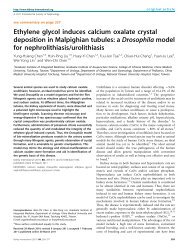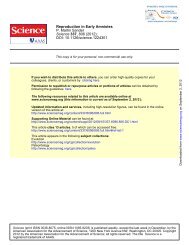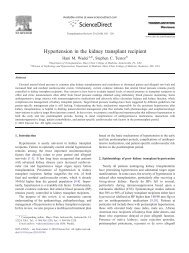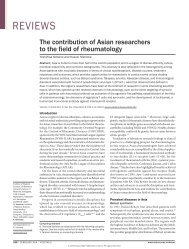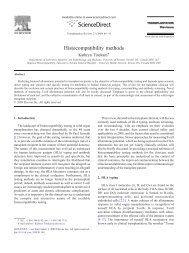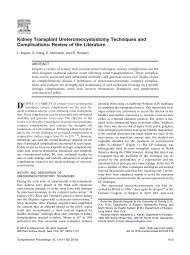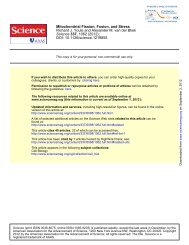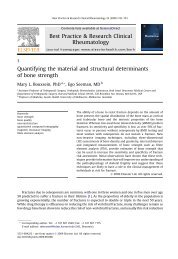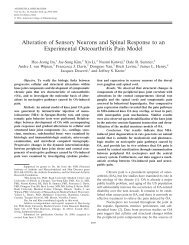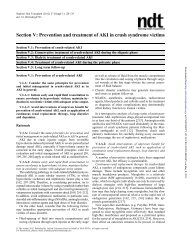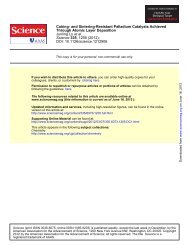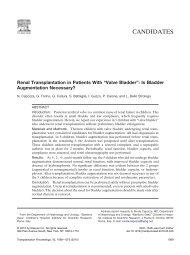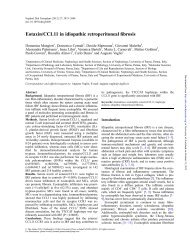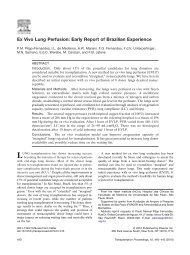Role of YAP/TAZ in mechanotransduction
Role of YAP/TAZ in mechanotransduction
Role of YAP/TAZ in mechanotransduction
Create successful ePaper yourself
Turn your PDF publications into a flip-book with our unique Google optimized e-Paper software.
RESEARCH ARTICLE<br />
METHODS<br />
Reagents, micr<strong>of</strong>abrications and plasmids. Cell-permeable C3 transferase<br />
(Cytoskeleton Inc.) was used <strong>in</strong> serum-free conditions for MCF10A and MSC,<br />
<strong>in</strong> complete medium for HMVEC. Y27632, blebbistat<strong>in</strong>, nocodazole were from<br />
Sigma. Latruncul<strong>in</strong> A was from Santa Cruz. NSC23766 was from Tocris.<br />
Micropatterned glass slides were purchased from Cytoo SA; on every slide, square<br />
islands <strong>of</strong> different sizes were arrayed <strong>in</strong> quadrants, leav<strong>in</strong>g 70 mm <strong>of</strong> non-adhesive<br />
glass between each island; a control area evenly coated with fibronect<strong>in</strong> was also<br />
<strong>in</strong>cluded to let cells attach without geometric constra<strong>in</strong>ts. Fibronect<strong>in</strong>-coated<br />
hydrogels were synthesized accord<strong>in</strong>g to ref. 24. Micropost arrays were prepared<br />
accord<strong>in</strong>g to ref. 25, with microposts <strong>of</strong> 1 mm <strong>in</strong> diameter and 3 mm <strong>of</strong> centre-tocentre<br />
distance; elasticity <strong>of</strong> the micropillars was changed by modulat<strong>in</strong>g the<br />
amount <strong>of</strong> cross-l<strong>in</strong>ker (10% <strong>in</strong> the stiff micropillars, 5% <strong>in</strong> the elastic ones) and<br />
their length, as <strong>in</strong> ref. 12, to obta<strong>in</strong> nom<strong>in</strong>al spr<strong>in</strong>g constants <strong>of</strong> .10.9 nN mm 21 for<br />
rigid micropillars, and 1.39 nN mm 21 for the elastic ones. 5SA-<strong>YAP</strong>1 was subcloned<br />
<strong>in</strong>to pCSII-EF-MCS to produce lentiviral particles. 4SA-mouse <strong>TAZ</strong><br />
cDNA was synthesized ad hoc (GeneScript).<br />
Cell l<strong>in</strong>es, transfections and treatments. Mouse NMuMG cells were grown <strong>in</strong><br />
DMEM 10% FCS. Human MCF10A cells were grown <strong>in</strong> DMEM/F12 with 5%<br />
horse serum freshly supplemented with <strong>in</strong>sul<strong>in</strong>, epidermal growth factor, hydrocortisone<br />
and cholera tox<strong>in</strong>. Human MDA-MB-231 cells were grown <strong>in</strong> DMEM/<br />
F12 with 10% FBS. Bone marrow-derived MSC and HMVEC-L were purchased<br />
from Lonza and grown accord<strong>in</strong>g to the manufacturer’s <strong>in</strong>structions. siRNA<br />
transfections were done with Lip<strong>of</strong>ectam<strong>in</strong>e RNAi-MAX (Invitrogen) <strong>in</strong> antibiotics-free<br />
medium accord<strong>in</strong>g to manufacturer’s <strong>in</strong>structions. Sequences <strong>of</strong> siRNAs<br />
is provided <strong>in</strong> Supplementary Table 2. DNA transfections were done with<br />
TransitLT1 (Mirus Bio). Lentiviral particles were prepared by transiently transfect<strong>in</strong>g<br />
HEK293T cells with lentiviral vectors together with packag<strong>in</strong>g vectors<br />
(pMD2-VSVG and psPAX2). Luciferase assays with the established <strong>YAP</strong>/<strong>TAZ</strong>responsive<br />
reporter 43GTIIC-lux 26 were as <strong>in</strong> ref. 27 , and displayed as arbitrary<br />
units.<br />
For hydrogels, 5,000–10,000 cells per cm 2 were seeded <strong>in</strong> drop; after attachment,<br />
the wells conta<strong>in</strong><strong>in</strong>g the hydrogels were filled with appropriate medium.<br />
MSC and mammary cells were plated <strong>in</strong> growth medium and harvested for<br />
immun<strong>of</strong>luorescence after 24 h; for luciferase and gene expression after 48 h.<br />
For bone differentiation assays, growth medium was changed with osteogenic<br />
differentiation medium 24 h after seed<strong>in</strong>g, and renewed every 2 days for a total <strong>of</strong><br />
8 days <strong>of</strong> differentiation. Bone differentiation was assayed by alkal<strong>in</strong>e phosphatase<br />
sta<strong>in</strong><strong>in</strong>g (Sigma 85L2) and quantified with ImageJ s<strong>of</strong>tware as follows: for<br />
each sample, at least five low magnification (320) pictures were taken, and the<br />
alkal<strong>in</strong>e-phosphatase-positive area was determ<strong>in</strong>ed with ImageJ as the number <strong>of</strong><br />
blue pixels across the picture; this value was then normalized to the number <strong>of</strong><br />
cells (Hoechst/nuclei) for each picture (arbitrary units). For adipogenic differentiation,<br />
growth medium was replaced with adipogenic <strong>in</strong>duction medium 24 h<br />
after seed<strong>in</strong>g; cells were then subjected to cycles <strong>of</strong> 3 days <strong>of</strong> adipogenic <strong>in</strong>duction<br />
and 1 day <strong>of</strong> adipogenic ma<strong>in</strong>tenance until harvest<strong>in</strong>g at day 7 <strong>of</strong> differentiation.<br />
Adipogenic differentiation was assayed by Oil Red sta<strong>in</strong><strong>in</strong>g (Sigma) and quantified<br />
as the Oil Red-positive area normalized to the number <strong>of</strong> cells (Hoechstpositive<br />
nuclei) <strong>in</strong> a manner similar to that described for bone differentiation.<br />
For micropatterns and micropost arrays, 40,000 HMVEC or MSC cells were<br />
plated <strong>in</strong> 35-mm dishes <strong>in</strong> growth medium. For immun<strong>of</strong>luorescence, cells were<br />
fixed 24 h after plat<strong>in</strong>g. For HMVEC proliferation and apoptosis assays, cells were<br />
fixed 24 h after plat<strong>in</strong>g (<strong>in</strong>clud<strong>in</strong>g 1 h <strong>in</strong>cubation with BrdU <strong>in</strong> the case <strong>of</strong> proliferation<br />
assays) and processed accord<strong>in</strong>g to TUNEL or BrdU detection kits<br />
(Promega DeadEnd and Roche Kit number 1, respectively). The projected cell<br />
area <strong>of</strong> cells on fibronect<strong>in</strong>-coated glass slides and on microposts was determ<strong>in</strong>ed<br />
with imageJ based on immun<strong>of</strong>luorescence pictures <strong>of</strong> cells sta<strong>in</strong>ed with anti-<br />
<strong>YAP</strong>/<strong>TAZ</strong>; the area <strong>of</strong> ECM contacted by cells was estimated by calculat<strong>in</strong>g that<br />
microposts (diameter 1 mm) arrayed <strong>in</strong> equilateral triangles (centre-to-centre<br />
3 mm) approximate 10% <strong>of</strong> the total surface covered by cells (projected cell area).<br />
For drug treatments and immun<strong>of</strong>luorescence, 10,000 cells per cm 2 were plated<br />
onto 8-well glass Lab-Tek chamberslides (Nunc) precoated for 1 h at 37 uC with<br />
20 mgml 21 bov<strong>in</strong>e fibronect<strong>in</strong> (Sigma) <strong>in</strong> 13 PBS. Unless <strong>in</strong>dicated otherwise,<br />
drug concentrations are <strong>in</strong>dicated <strong>in</strong> the legend to Fig. 2a and d, and treatments<br />
lasted 4 h for immun<strong>of</strong>luorescence, 6 h for western blott<strong>in</strong>g, and overnight for<br />
luciferase and gene expression assays. For serum stimulations, cells were <strong>in</strong>cubated<br />
overnight without serum and then stimulated for 6 h with 20% serum; for<br />
comb<strong>in</strong>ed treatments, drugs were added together with 20% serum.<br />
Antibodies, western blott<strong>in</strong>g and immun<strong>of</strong>luorescence. Western blott<strong>in</strong>g was<br />
carried out as <strong>in</strong> ref. 28. Immun<strong>of</strong>luorescence was as <strong>in</strong> ref. 29. Antibodies: anti-<br />
<strong>YAP</strong>/<strong>TAZ</strong> 1:200 for immun<strong>of</strong>luorescence (sc101199 detect<strong>in</strong>g both <strong>YAP</strong> and <strong>TAZ</strong><br />
<strong>in</strong> western blot), anti-<strong>YAP</strong> 1:100 for immun<strong>of</strong>luorescence (sc271134 detect<strong>in</strong>g only<br />
<strong>YAP</strong> <strong>in</strong> western blot, used <strong>in</strong> Supplementary Fig. 5), anti-phosphoS127-<strong>YAP</strong> (CST<br />
©2011<br />
Macmillan Publishers Limited. All rights reserved<br />
4911), anti-LATS1 (CST 3477), anti-LATS2 (Abnova ab70565), anti-GAPDH<br />
(Millipore mAb374), anti-v<strong>in</strong>cul<strong>in</strong> 30,31 (VIN-11-5). Primary antibodies for immun<strong>of</strong>luorescence<br />
were <strong>in</strong>cubated overnight <strong>in</strong> PBS with 0.1% Triton and 2% goat<br />
serum. Secondary antibodies were GAM Alexa488, GAM Alexa568 and GAR<br />
Alexa555 (Invitrogen). YOYO1, TOTO3 (Invitrogen) or Hoechst were used <strong>in</strong><br />
comb<strong>in</strong>ation with RNase to countersta<strong>in</strong> nuclei. Alexa 488-conjugated phalloid<strong>in</strong><br />
(Invitrogen) was used 1:100 <strong>in</strong> 1% BSA to visualize F-act<strong>in</strong> micr<strong>of</strong>ilaments. Firmsett<strong>in</strong>g<br />
anti-fade mount<strong>in</strong>g medium was 10% Mowiol 4-88, 2.5% DABCO, 25%<br />
glycerol, 0.1 M Tris-HCl pH 8.5. Images were acquired with a Leica SP2 confocal<br />
microscope equipped with a CCD camera. Cells seeded on microposts were<br />
observed <strong>in</strong> 13 PBS with a Bio-Rad upright confocal microscope with water<br />
immersion long-range objectives. Pictures <strong>of</strong> cells seeded on small adhesive islands<br />
were rescaled to allow better visualization <strong>of</strong> immunosta<strong>in</strong><strong>in</strong>gs. For quantifications<br />
<strong>of</strong> <strong>YAP</strong>/<strong>TAZ</strong> subcellular localizations, <strong>YAP</strong>/<strong>TAZ</strong> immun<strong>of</strong>luorescence signal was<br />
scored as predom<strong>in</strong>antly nuclear versus evenly distributed/predom<strong>in</strong>antly cytoplasmic<br />
<strong>in</strong> 150–200 cells for each experimental condition.<br />
Real-time PCR. Cultures were harvested <strong>in</strong> TRIzol (Invitrogen) for total RNA<br />
extraction, and contam<strong>in</strong>ant DNA was removed by DNase I treatment. cDNA<br />
synthesis was carried out with dT-primed MuMLV Reverse Transcriptase<br />
(Invitrogen). Real-time qPCR analyses were carried out on triplicate sampl<strong>in</strong>gs<br />
<strong>of</strong> retrotranscribed cDNAs with RG3000 Corbett Research thermal cycler and<br />
analysed with Rotor-Gene Analysis6.1 s<strong>of</strong>tware. Expression levels are given relative<br />
to GAPDH. Sequences <strong>of</strong> primers are provided <strong>in</strong> Supplementary Table 3.<br />
Biostatistical analysis. The statistical association between genes differentially<br />
expressed <strong>in</strong> mammary epithelial cells (MEC) cultivated on ECM <strong>of</strong> high/low<br />
stiffness (stiffness signature) and belong<strong>in</strong>g to signal transduction pathways is<br />
assessed by an over-representation analysis approach us<strong>in</strong>g Fisher’s exact test.<br />
Briefly, consider<strong>in</strong>g that there are S s<strong>in</strong>gle-symbol-annotated genes on the stiffness<br />
signature, the over-representation <strong>of</strong> a pre-def<strong>in</strong>ed pathway signature is<br />
calculated as the hypergeometric probability <strong>of</strong> hav<strong>in</strong>g a genes for a specific<br />
pathway <strong>in</strong> S, under the null hypothesis that they were picked out randomly from<br />
the N total genes <strong>of</strong> the microarray. Over-representation analysis has been conducted<br />
us<strong>in</strong>g one-sided Fisher’s exact test (phyper function <strong>of</strong> R stats package;<br />
P-value , 0.05) and consider<strong>in</strong>g 19,621 s<strong>in</strong>gle-symbol-annotated genes on the<br />
HG-U133 Plus2.0 microarray. P-values have been adjusted for false discovery rate<br />
(p.adjust function <strong>of</strong> R stats package; FDR , 5%).<br />
The stiffness signature has been derived from Supplementary Table 1 <strong>of</strong> ref. 9.<br />
The complete signature conta<strong>in</strong>s 1,236 probe sets <strong>of</strong> the Affymetrix 430 2.0 mouse<br />
array account<strong>in</strong>g for 1,015 s<strong>in</strong>gle-symbol-annotated. MOE430 Plus2.0 probe IDs<br />
have been converted to the correspondent HG-U133 Plus2.0 probe sets us<strong>in</strong>g the<br />
NetAffx orthologue annotation file derived from the NCBI HomologoGene database<br />
(MOE430A Orthologues/Homologues Release 30, http://www.affymetrix.<br />
com/). This conversion table allows mapp<strong>in</strong>g orthologous probe sets (that is,<br />
probe sets <strong>in</strong>terrogat<strong>in</strong>g transcripts from orthologous genes) across two<br />
Affymetrix types <strong>of</strong> arrays. The 1,236 mouse probe sets <strong>of</strong> the stiffness signature<br />
were converted <strong>in</strong>to 1,793 human probe sets correspond<strong>in</strong>g to 807 s<strong>in</strong>gle-symbolannotated<br />
genes. Similarly, probe sets <strong>of</strong> all pathway signatures have been first<br />
converted <strong>in</strong>to HG-U133 Plus2.0 probe sets, and then annotated as gene symbols<br />
us<strong>in</strong>g Bioconductor hgu133plus2.db package (release 2.3.5). Gene-sets <strong>of</strong> specific<br />
signall<strong>in</strong>g pathways have been derived from: TGFba 32 ; TGFbb 33 ; H-Ras and<br />
b-caten<strong>in</strong> 34 ; ERBB2 35 ; <strong>YAP</strong> 36–38 ; <strong>YAP</strong>/<strong>TAZ</strong> 39 ;WNT 40 ; Notch and NICD 41 . The<br />
‘‘<strong>YAP</strong>/<strong>TAZ</strong> signature’’ was published as supplemental table <strong>in</strong> ref. 39. The second<br />
‘‘<strong>YAP</strong> signature’’ <strong>of</strong> Supplementary Fig. 2 is provided <strong>in</strong> Supplementary Table 1.<br />
See Supplementary Tables 4, 5 and 6 for the follow<strong>in</strong>g signatures, that were<br />
derived from the microarrays published <strong>in</strong>: MAL/SRFa 42 ; MAL/SRFb 43 ; NFkB<br />
44 . Genes <strong>of</strong> WNT and b-Caten<strong>in</strong> pathway lists were not represented <strong>in</strong> the<br />
stiffness signature.<br />
24. Tse, J. R. & Engler, A. J. Preparation <strong>of</strong> hydrogel substrates with tunable mechanical<br />
properties. Curr. Protoc. Cell Biol. 47, 10.16.1–10.16.16 (2010).<br />
25. du Roure, O. et al. Force mapp<strong>in</strong>g <strong>in</strong> epithelial cell migration. Proc. Natl Acad. Sci.<br />
USA 102, 2390–2395 (2005).<br />
26. Mahoney, W. M. Jr, Hong, J. H., Yaffe, M. B. & Farrance, I. K. The transcriptional coactivator<br />
<strong>TAZ</strong> <strong>in</strong>teracts differentially with transcriptional enhancer factor-1 (TEF-1)<br />
family members. Biochem. J. 388, 217–225 (2005).<br />
27. Martello, G. et al. A MicroRNA target<strong>in</strong>g Dicer for metastasis control. Cell 141,<br />
1195–1207 (2010).<br />
28. Dupont, S. et al. FAM/USP9x, a deubiquit<strong>in</strong>at<strong>in</strong>g enzyme essential for TGFb<br />
signal<strong>in</strong>g, controls Smad4 monoubiquit<strong>in</strong>ation. Cell 136, 123–135 (2009).<br />
29. Morsut, L. et al. Negative control <strong>of</strong> Smad activity by ectoderm<strong>in</strong>/Tif1c patterns the<br />
mammalian embryo. Development 137, 2571–2578 (2010).<br />
30. Galbraith, C. G., Yamada, K. M. & Sheetz, M. P. The relationship between force and<br />
focal complex development. J. Cell Biol. 159, 695–705 (2002).<br />
31. Giannone, G., Jiang, G., Sutton, D. H., Critchley, D. R. & Sheetz, M. P. Tal<strong>in</strong>1 is critical<br />
for force-dependent re<strong>in</strong>forcement <strong>of</strong> <strong>in</strong>itial <strong>in</strong>tegr<strong>in</strong>-cytoskeleton bonds but not<br />
tyros<strong>in</strong>e k<strong>in</strong>ase activation. J. Cell Biol. 163, 409–419 (2003).



